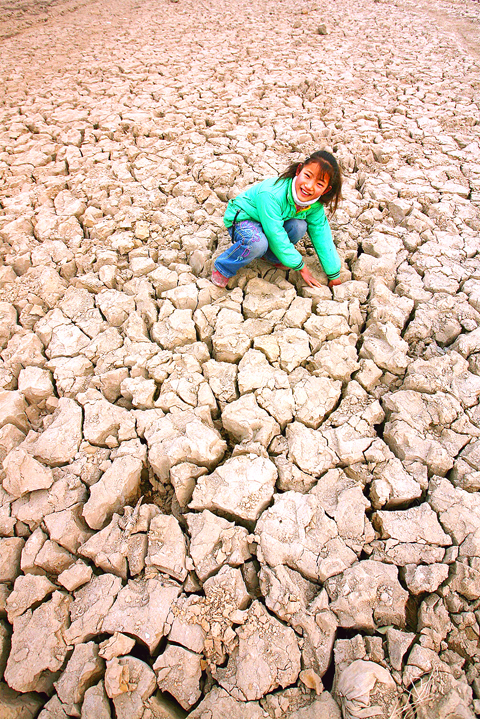China was struggling yesterday to get water to millions of people and save swathes of its wheat harvest, after raising its drought emergency status to the highest level for the first time.
The decision to go to emergency level one was taken on Thursday at a meeting of the State Flood Control and Drought Relief Headquarters, Xinhua news agency reported.
Eight provinces and municipalities are affected, stretching in a broad belt from Gansu on the Mongolian border in the northwest to Shandong on the Yellow Sea in the east.

PHOTO: AFP
About 43 percent of the country’s winter wheat supplies are at risk, as some areas have seen no rain for 100 days or more, state media said.
The increased alert level was made official at the same time as the central government sent out specialists to the major drought-hit regions to help residents with relief supplies and technical aid, the China Daily said.
About 4.3 million people and 2.1 million head of livestock are short of water, the relief headquarters said in a statement, as parts of the nation experience their worst drought since the early 1950s.
Chinese Vice Premier Hui Liangyu (�?}) held a state conference on Thursday to coordinate and strengthen efforts to help the affected regions, calling for quick financial and material support, the China Daily reported.
Hui also urged local governments to speed up the construction of irrigation systems for crops, the paper said, although it was unclear if this could be done fast enough to help alleviate the current crisis.
The dry spell highlights one of China’s main long-term worries, as water resources are becoming rapidly depleted due to fast economic growth.
Beijing, is particularly badly hit, with experts warning the city, home to 17 million people, will soon have reached the limit beyond which there will not be enough water to go around.
Last September authorities were forced into a six-month emergency diversion scheme that is seeing water being pumped from neighboring Hebei Province to Beijing.
The water flows along a 305km canal stretching from the Hebei capital of Shijiazhuang to Beijing and fed by three major reservoirs.
The canal is part of China’s ambitious North-South Water Diversion Project, a multi-billion dollar scheme to bring water from the nation’s longest river, the Yangtze, to the parched north.
Shaanxi Province, among the areas hardest hit by the drought, will try to induce rain or snowfall to relieve parched soil.
The province will time the effort to coincide with when a weak cold front from the Xinjiang Autonomous Region meets a warm stream from the southwest, the China Meteorological Administration said on its Web site yesterday. Local agencies will use rockets, cannon and aircraft to fire chemicals into the sky to seed the clouds and increase rainfall.
About 210 rockets and 400 cannons are in place, the report said. Airplanes will be deployed for man-made rains from late this month to next month, it said.

CHANGE OF MIND: The Chinese crew at first showed a willingness to cooperate, but later regretted that when the ship arrived at the port and refused to enter Togolese Republic-registered Chinese freighter Hong Tai (宏泰號) and its crew have been detained on suspicion of deliberately damaging a submarine cable connecting Taiwan proper and Penghu County, the Coast Guard Administration said in a statement yesterday. The case would be subject to a “national security-level investigation” by the Tainan District Prosecutors’ Office, it added. The administration said that it had been monitoring the ship since 7:10pm on Saturday when it appeared to be loitering in waters about 6 nautical miles (11km) northwest of Tainan’s Chiang Chun Fishing Port, adding that the ship’s location was about 0.5 nautical miles north of the No.

A Chinese freighter that allegedly snapped an undersea cable linking Taiwan proper to Penghu County is suspected of being owned by a Chinese state-run company and had docked at the ports of Kaohsiung and Keelung for three months using different names. On Tuesday last week, the Togo-flagged freighter Hong Tai 58 (宏泰58號) and its Chinese crew were detained after the Taipei-Penghu No. 3 submarine cable was severed. When the Coast Guard Administration (CGA) first attempted to detain the ship on grounds of possible sabotage, its crew said the ship’s name was Hong Tai 168, although the Automatic Identification System (AIS)

COORDINATION, ASSURANCE: Separately, representatives reintroduced a bill that asks the state department to review guidelines on how the US engages with Taiwan US senators on Tuesday introduced the Taiwan travel and tourism coordination act, which they said would bolster bilateral travel and cooperation. The bill, proposed by US senators Marsha Blackburn and Brian Schatz, seeks to establish “robust security screenings for those traveling to the US from Asia, open new markets for American industry, and strengthen the economic partnership between the US and Taiwan,” they said in a statement. “Travel and tourism play a crucial role in a nation’s economic security,” but Taiwan faces “pressure and coercion from the Chinese Communist Party [CCP]” in this sector, the statement said. As Taiwan is a “vital trading

‘STRONG GENERATION’: The DPP has alleged that the TPP legislator-at-large used his position to help businesses affiliated with his wife, siblings, children and in-laws Taiwan People’s Party (TPP) Legislator-at-large Wu Chun-cheng (吳春城), who has been accused of conflicts of interest related to his support for a “strong generation,” yesterday said he would resign from his post. The Act Promoting Development for Strong Generation Policies and Industries (壯世代政策與產業發展促進法) was passed on Jan. 7 to address aging through industrial development. It defines the “strong generation” as those aged 55 or older with the ability and willingness to work, and stipulates that the government is responsible for putting in place policies that help those in the aging population lead a better life. Wu, known for initiating the act, at